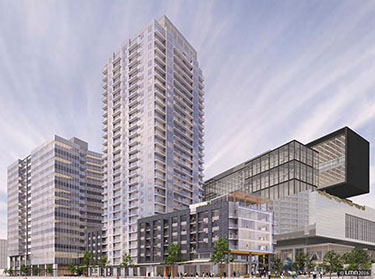|
Subscribe / Renew |
|
|
Contact Us |
|
| ► Subscribe to our Free Weekly Newsletter | |
| home | Welcome, sign in or click here to subscribe. | login |
Real Estate
| |
 Nat Levy Real Estate Reporter |
May 19, 2016
Real Estate Buzz: Convention Center expansion will appeal to locals, too
Real Estate Reporter
The goal of the Washington State Convention Center is to bring more conventions to Seattle, but much of the ground floor will be designed to appeal to locals as much as convention goers.
Matt Griffin of Pine Street Group, development manager for the $1.4 billion expansion, said at a NAIOP event Wednesday that he wants to bring some of the retail touches that made his Via6 project in Belltown so popular to the WSCC addition, one example being restaurants and retail with indoor and outdoor elements.
WSCC has brought in Jim Graham of Graham Baba Architects to work on that part of the project.
Making the street level pedestrian-friendly and heavy on retail will “break up this big convention center and make it feel more like our own neighborhood,” Griffin said.
The addition will fill in what is today the Convention Place Station. That station was due to go away soon — light rail doesn't use it, and in a couple of years there will be no buses in the Downtown Transit Tunnel — and Griffin wants that block to become more of a pedestrian hotspot.
Griffin sees the prime corner of Pine and Boren as a centerpiece of that idea. It is owned by the Washington State Department of Transportation, and WSCC would lease that land. Griffin said he envisions something like a distillery or a pub on that corner that could pull people from Capitol Hill and downtown.
The expansion will house about 250,000 square feet of new exhibition space, 120,000 square feet of meeting rooms, 60,000 square feet of ballroom space, 20 loading bays, and parking for about 700 vehicles.
The structure will have 11 stories above ground and two stories underground.
One of the main features is a 150,000-square-foot underground exhibition hall. To put the size of that in perspective, Griffin said the floorplate of the first floor of Pacific Place is about 85,000 square feet. It also has pre-function space and loading support on the same floor.
“Basically having that one room with those capacities gives us the tools to chase other conventions that most of the other places in the country can't,” Griffin said.
The expansion includes some “co-development” projects: a 29-story tower with 409 apartments at 920 Olive Way; and a 16-story, 500,000-square-foot office building at 1711 Boren Ave. The towers will go on two sites north of the proposed expansion.
The goal is to begin construction on the WSCC expansion next summer and finish in 2020. Griffin previously told the DJC the most practical time to start the apartment and office towers would be 12 to 18 months after work begins on the expansion so that all the elements can open together.
But there is still a lot of work left before construction can begin on the expansion. Griffin said the co-development projects received design review approval earlier this week, and the convention center expansion is still going through that process. WSCC is also seeking five alley and street vacations for the expansion, mostly so that parts of the convention center can be put underground. After that, the team plans to rebuild the streets.
LMN Architects is designing the expansion and the co-development towers. Magnusson Klemencic Associates is providing structural and civil engineering services.
A joint venture of Skanska and Hunt Construction Group was the GC/CM but that contract was terminated earlier this year. A legal dispute between the WSCC and Skanska-Hunt was resolved in April, and now Pine Street Group and WSCC are working to find a new contractor.
Griffin previously told the DJC that the WSCC board of directors has asked for information on three possible options: negotiating with the other two finalists on the original bid: Mortenson Construction with PCL Construction Services and Clark Construction Group with Lease Crutcher Lewis; starting the procurement process for a new GC/CM; and going with a traditional design-bid-build contract.
Want an affordable house? Move to West Richland
The price of a house typically gets the most attention, but closing costs, taxes and homeowner's insurance play a big role in how much a homeowner ultimately pays.
In Washington, the most affordable place to own a home, relative to the median income, is West Richland, a suburb of Richland in the Tri-Cities area, according to a report from financial tech company SmartAsset. It has the third highest median income among the top 10 affordable cities in the state and costs are lower than several cities with lower incomes.
Half of the most affordable cities are on the east side of the state. They are West Richland, Connell, Prosser, Ephrata and Richland. Two of the top 10 cities — Woodland and Ridgefield — are close to the Oregon-Washington border. The other three — Maple Valley, Ortin and Tracyton — are in the Puget Sound region.
Maple Valley is the only King County city to make the top 10 most affordable list in the state. Its high median income of $97,809 helps offset the highest average annual mortgage payment, closing costs, property taxes and homeowner's insurance among the top 10 affordable cities.
Bellevue and Seattle were ranked 101st and 102nd, respectively, in terms of affordability, out of 105 cities in Washington.
No Pacific Northwest city was among SmartAsset's most affordable cities in the U.S. California City, California was the only city west of Texas to make the top 10.
Got a tip? Contact DJC real estate editor Brian Miller at brian.miller@djc.com or call him at (206) 219-6517.
Previous columns:
- Real Estate Buzz: Valve eyes big space in Lincoln Square tower, 05-05-2016
- Real Estate Buzz: Portland developer using crowdfunding for Fair-Haired Dumbbell office project, 04-28-2016
- Real Estate Buzz: Condo demand rising faster than the supply, 04-07-2016
- Real Estate Buzz: New green building certification focuses less on structures, more on people who use them, 03-31-2016
- Real Estate Buzz: New owners revamp Seattle Design Center, 03-24-2016
- Real Estate Buzz -- OneRent: Startup uses an Uber approach to streamline property management services, 03-10-2016
- Real Estate Buzz: So here's the low down on Luma, which opens in June on First Hill, 03-03-2016
- Real Estate Buzz: This development cycle is in 7th inning, but experts say the game's not over yet, 02-25-2016



